New Innovations in Vertical Air Conditioning
How building owners, installers, and occupants benefit from a quicker install and simplified design
![]() Continuing Education
Continuing Education
Use the following learning objectives to focus your study while reading this month’s Continuing Education article.
Learning Objectives - After reading this article, you will be able to:
- Discuss how new vertical terminal air conditioning (VTAC) technologies lead to savings in time and costs.
- Describe what makes VTAC technology easy to install and how that plays into current skilled labor shortages.
- List three new features that a VTAC system can provide that lead to comfort for the building occupant.
- Explain how new VTAC technologies can lend themselves to aesthetic needs in hospitality and related industries.
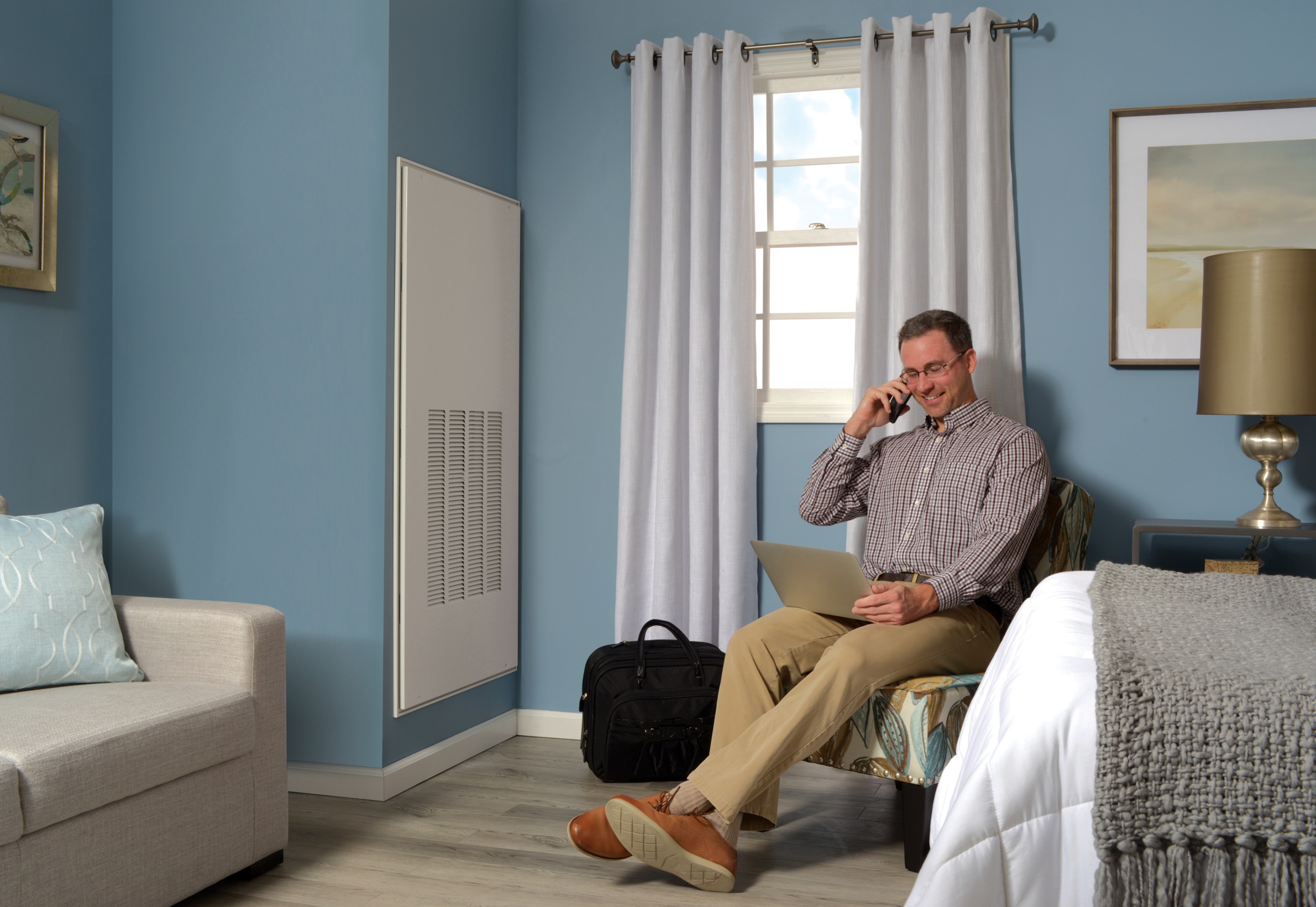
All images courtesy of GE Appliances Air & Water Solutions
The VTAC system fits unobtrusively into a room and is quiet and easy to use, providing occupants with a more enjoyable experience.
Evolution of VTAC technology
Air conditioning systems were once considered a luxury, but now they are an essential item for most buildings — from offices to hospitals and from multifamily and single-family homes to hotels. Important breakthroughs have led to innovative air conditioning systems that feature easy installation, clean and compact designs, energy efficiency, and lower costs.
In 1902, Willis Carrier designed the first modern electrical air conditioning unit, and in 1904, Americans experienced the concept of comfort cooling at the St. Louis World’s Fair, where mechanical cooling was used to cool the Missouri State Building. Though costs for cooling units were high, by 1947, engineer Henry Galson had developed compact window air conditioners that could be easily manufactured on production lines, lowering the cost and making them more available to the public. Energy efficiency standards also developed over this timeline, which helped drive improvements in the technology.
Vertical air conditioning is a technology that has raised the bar in achieving the needs of owners, installers, and occupants. The systems are self-contained in a vertical cabinet and allow for installation in places where space is tighter and for easy and economical transportation. Ambient air inside a room is pulled through the return, and the conditioned air is sent back into the room through the supply. On the outside, air is pulled into the system to help with the condensing and cooling process. Heat removed during the cooling process is exhausted to the outdoors.
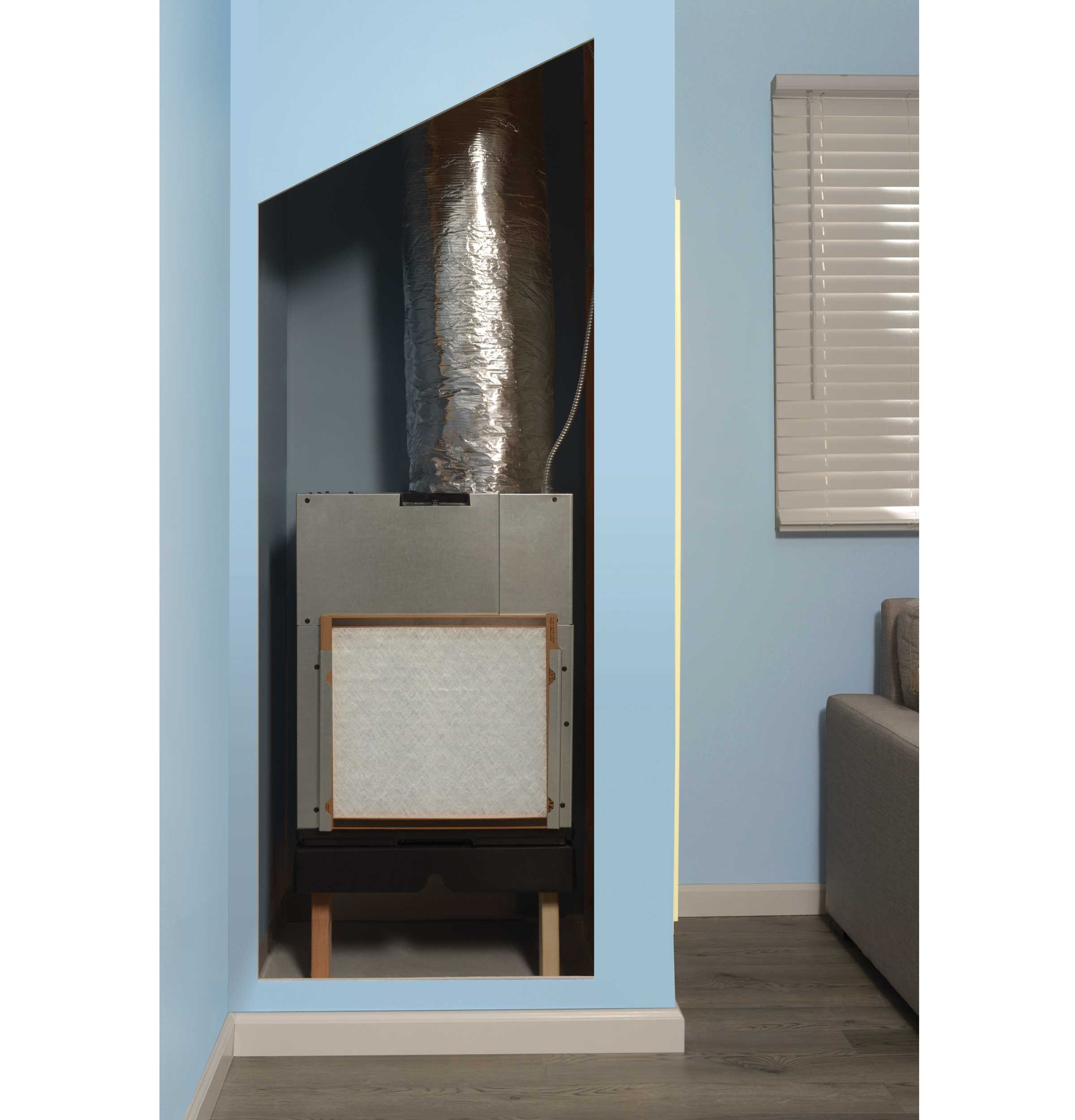
A vertical terminal air conditioning (VTAC) system is a heating-cooling unit that can be installed in a space hidden from view, like a closet, and it can control the temperature of a single room or multiple adjoining rooms in a building.
One of the newest innovations in vertical air conditioning is a vertical terminal air conditioning (VTAC) system, also known as a single packaged vertical unit (SPVU). An SPVU is a compact, through-the-wall packaged system that provides total heating and cooling functions for a single zone or multiple rooms. A VTAC is a heating-cooling unit that can be installed in a space hidden from view, like a closet, and it can control the temperature of a single room or multiple adjoining rooms in a building. VTACs are especially desirable in hotel and motel rooms, assisted-living centers, offices, and apartments or condos where space is limited or where an out-of-sight quality is preferred. Their ability to be concealed provides better aesthetic qualities and sound reduction while still offering the cool environment necessary for occupant comfort.
Like a regular packaged terminal unit, the latest VTAC system is installed through the wall, but instead of being 42 inches wide and installed in the middle of the room, it has a vertical configuration and is installed in an enclosure, which gives the space a more home-like appearance. It has a top-air discharge that is ducted into a single room or multiple rooms. It is controlled by a wall-mounted thermostat similar to those found in most homes but provides more precise settings. Because it doesn’t need to be installed under a window in the middle of the room, curtains can hang all the way to the floor, and more versatile room designs are possible. It provides the cost benefit of packaged terminal units with the aesthetics, quieter operation, and flexibility of a central system.
VTAC systems have several important qualities including versatility, sound control, and power. But some of the latest innovations in VTAC also include easy installation and a lower price tag. These new systems were developed in collaboration with hotel owners, residential property owners, and architects. This collaboration is important because building owners were able to address important feedback from occupants in terms of noise and user ease. They were also able to provide input about difficulties in installation and help provide inspiration to manufacturers for developing systems that better satisfied installers, occupants, and owners. In addition, architects were able to offer feedback on aesthetic design — what kind of system could mesh with their vision of a pleasing space.
The new technology is also fitting for the times when pandemic life has created new concerns for indoor activities. As the architectural and construction world adapts to the need for new designs, air conditioning is yet another element that has evolved to provide innovative solutions for the health, safety, and well-being of occupants.
Innovation in air conditioning systems and better installation
When it comes to new VTAC technologies, products can occupy a sweet spot of being low maintenance but still providing high-end guest comfort and reliable performance. This section will explore the new VTAC technology in detail, including focusing on 10 innovative features that benefit the user and lend themselves to easy installation.
Installation features and details
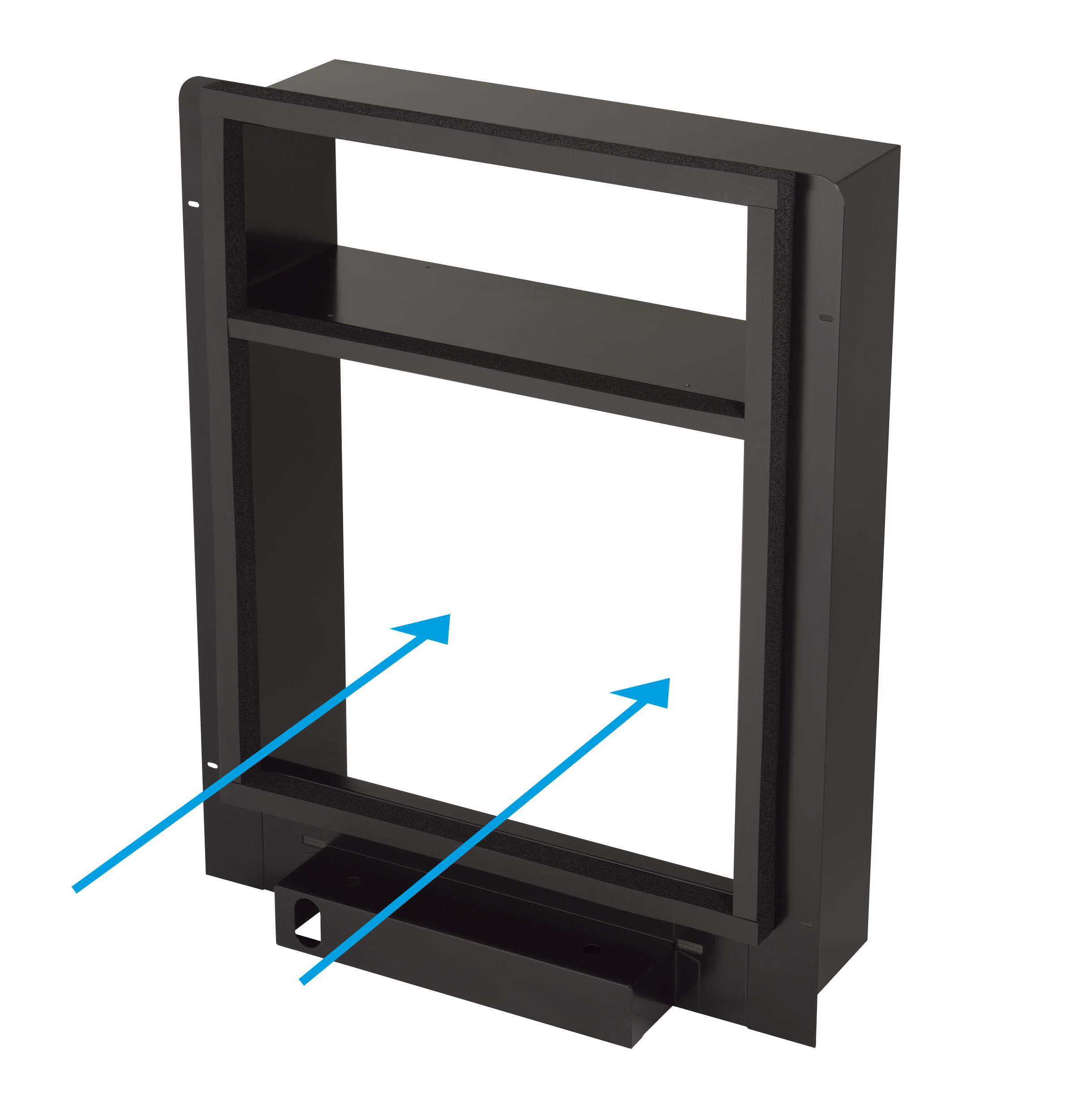
The plenum is easily installed from the interior of the building without needing to access it from the exterior.
The latest VTAC design features a new chassis and platform created by engineers who collaborated with builders, property owners, and architects. The process begins with installing the wall plenum, which first requires measuring the depth of the wall opening and adding a quarter inch to the measurement. That will be the required depth of the adjustable depth plenum. If the opening is less than 7.5 inches, no adjustment is required. The new wall plenum is expandable to work with walls 8 to 15 inches inches thick; adjustments can be made and are discussed in the manufacturer’s manual. Attach the grille to the wall plenum, which can be aligned with the screws and pushed through the keyhole slots. Once the grille is square with the plenum, you can tighten the screws. Apply caulking to the wall and framing opening. Once that’s done, the plenum can slide into the wall and should be attached with four screws (two on each side). When the plenum is secure, apply caulk to the seam of the plenum, between the inner and outer halves of the plenum, putting the caulk at least 3 inches up each side. Caulk should also be applied to the outside of the building around the perimeter of the plenum to ensure a water-tight seal.
The platform is designed to integrate with the wall plenum and align the chassis with the plenum gasket for a tight seal. In the past, these platform installations required more complex customized construction, but the new system is a one-piece design that can adjust and be tailored to a given location. Because it can easily be installed, it eliminates the necessity of skilled-labor requirements.
The system is designed to allow the installation of the chassis from the front or either side of the closet. This provides greater flexibility in building and room design and unit placement. If access to the front of the unit is restricted by a wall or furniture placement, the chassis can slide in from either side of the closet. If an alcove or offset is designed into the building facade, the three-way slide-out chassis enables the unit to be easily installed and removed for service.
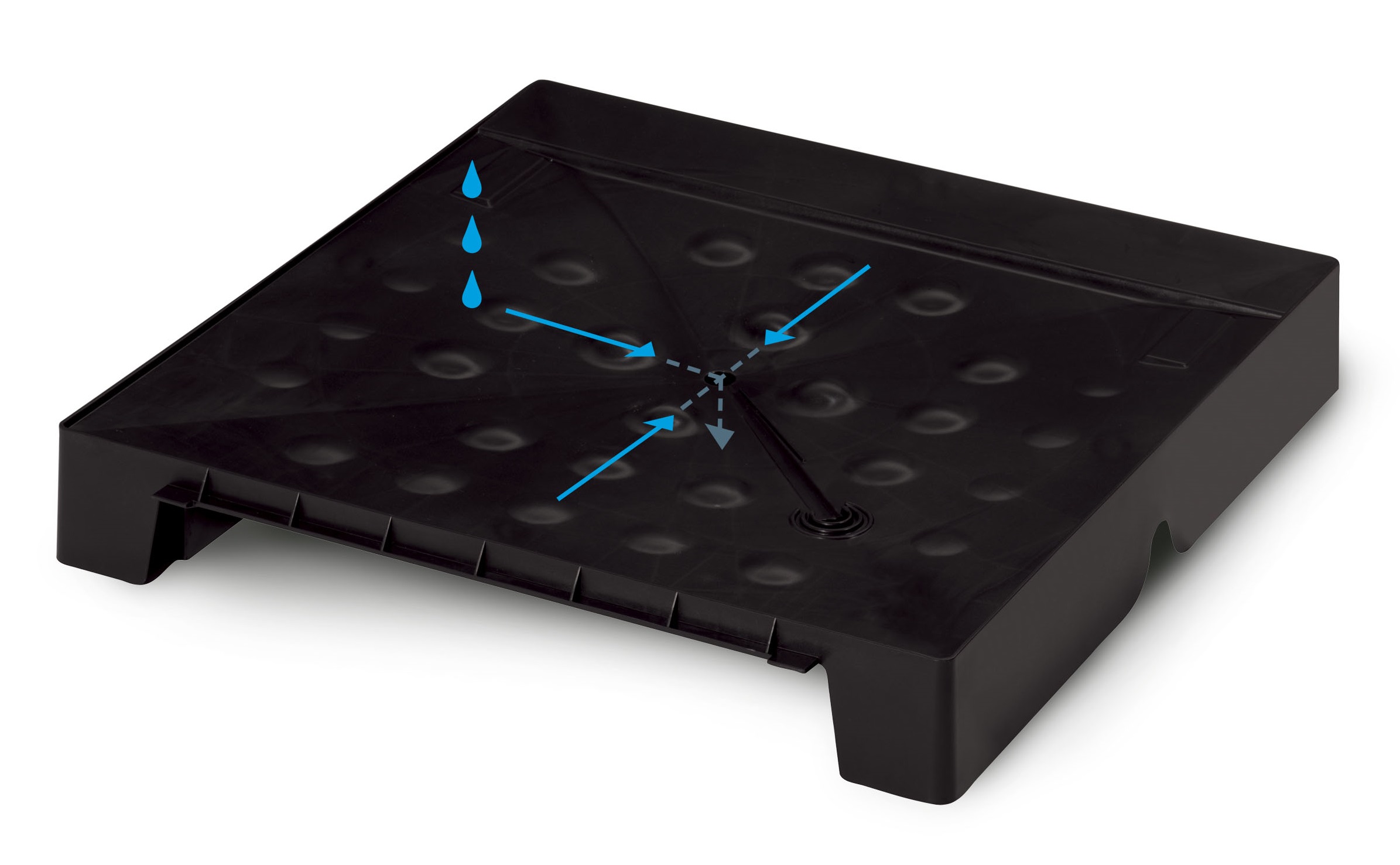
Easy installation of the self-contained drainage system allows for simple chassis removal while leaving plumbing completely intact.
The platform includes a self-contained drainage system and features notches on each side and the front of the platform for the primary drain to exit. This feature allows flexibility in plumbing connections and adapts to varying site conditions. Easy installation allows for simple chassis removal while leaving the plumbing completely intact.

The fast-connect plumbing design has threaded plumbing fittings can be used to attach primary and secondary drain fittings to the platform.
The VTAC design has simple, easy-to-install plumbing. Easy use threaded plumbing fittings can be used to attach primary and secondary drain fittings to the platform. In this type of system, the primary drainpipe needs to be 12.5 inches long to extend beyond the platform so it can easily be connected to the building drain line, while the secondary drainpipe (which goes into the plenum) should be no longer than 8 inches to allow for the platform to attach easily to the wall plenum. Two 2 x 4 supports, which can be cut to size, are placed in pockets under the platform on the side opposite the plenum. Measure from the floor to the bottom of the side flange of the plenum and then add 3 inches to determine the length of the 2 x 4 supports. With the primary and secondary drain fittings installed, as well as two 2 x 4 front supports installed, the platform assembly can be integrated with the wall plenum. Holding the platform at approximately 15°, align the locking pins and tabs of the platform to the corresponding holes and slots in the plenum. Then, lower the plenum until the 2 x 4 supports meet the floor in a level position.
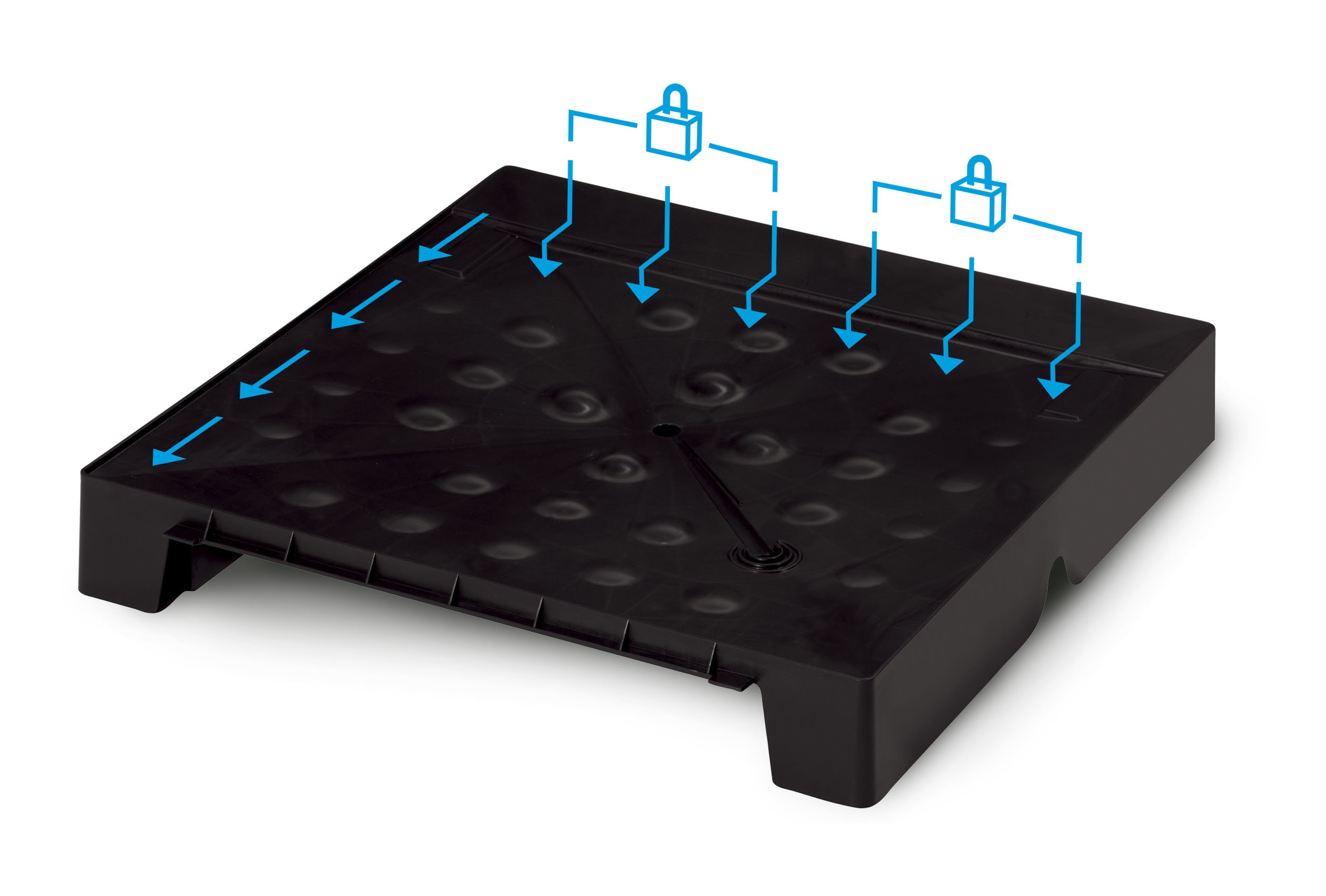
The locking ledge of the self-aligning system secures the chassis to the platform for a perfect fit and seal.
Then, the chassis can be installed onto the platform. The locking ledge technology of the self-aligning system provides a nearly foolproof installation experience. The locking ledge secures the chassis to the plenum gasket in a near-perfect fit and seal without any fasteners.
Those main features — wall plenum, platform, drainage system, easy plumbing, and self-aligning technology — are key to making the VTAC unit a process that doesn’t require skilled labor. After these elements of the system are in place, remove the junction box cover from the chassis and locate the thermostat connector. Connect the thermostat connector wires to the field-supplied thermostat cable and use the instructions to determine the proper connection to the thermostat connector. Once the connections are complete, plug in the thermostat connector to the chassis. With the thermostat connected, use the round knockout hole in the top of the junction box to install the power wiring (or flex cable) coming from the branch circuit. Leave 8 inches of extra wire inside the junction box for the final electrical connection. Install the proper power supply kit matching the voltage and amperage of the branch circuit. When the wiring connections are complete, plug in the power connector and the personality plug. Reinstall the junction box cover.
Using a field supplied clamp, secure the flexible 10-inch duct to the discharge duct flange on top of the unit. Use a clamp to secure the other end of the flex duct to the air discharge box above the unit and finally, install the filter.
The unit is ready for operation at this point, but there are still more features to discuss that elevate this new technology above older vertical air conditioning units: ultra-quiet performance, reverse-cycle defrost, seacoast protection, onboard diagnostics, and smart Wi-Fi capability.
Quiet for better sleep

The ultra-quiet capability of the VTAC provides cool comfort without noise, for better indoor environmental quality and, ultimately, good sleep.
In their early development, air conditioning units were noisy. It was an inevitable side effect of a new system. Signs of maintenance issues came in the form of banging, screeching, hissing, and rattling, but sometimes those sounds were just par for the course — a necessary evil for the comforts of a cool indoor climate.
In the 1950s, rotary compressors were developed to help reduce noise, but while air conditioners have improved over the decades, they have continued to emit an unavoidable level of noise. More recently, however, ultra-quiet technology has been built into VTAC systems. The sound is smooth and unobtrusive in a way that doesn’t impede sleep, which is especially important in hotel rooms where individual units are located. In some cases, the divide between a louder air conditioning unit and an ultra-quiet unit is the difference between interrupted sleep and the kind of ambient white noise that can soothe people to sleep.
Reverse-cycle defrost for efficiency

The reverse cycle defrost technology increases efficiency enabling the unit to run in heat pump mode for longer.
Another feature is the reverse-cycle defrost, which increases efficiency and enables the unit to run in heat pump mode longer. Reverse-cycle defrost monitors the outdoor ambient temperature and outdoor coil temperature and will initiate a defrost cycle to the outdoor coil when it gets frosted up. Before the unit runs the defrost cycle, it ensures the room is at the set temperature and follows up with a resistance heating cycle when the defrost ends. Without this technology, the unit forms a layer of ice on the outdoor coil that impedes the heat exchange system. This would cause the VTAC to shift the heat source from heat pump to more expensive backup heating sooner.
Seacoast protection

A rust-proof basepan and platform provide another level of corrosion protection in environments that tend to have more salt and moisture in the air.
Air conditioning systems that are in contact with sea air risk corrosion. The millions of sodium chloride particles create a film on surfaces and attract moisture. The deterioration affects a/c systems, especially steel components. It also impacts the outdoor coil, which is made of copper tubes. If the coil fails, there is a domino effect wherein the system can no longer cool.
New VTAC technology features seacoast protection in the form of a rust-proof base pan and bulkhead as well as a corrosion-resistant coating on the outdoor coils. Other anti-corrosive measures on components include an enclosed fan motor with painted casings, a coating on the outdoor coil, use of coated screws and stainless-steel brackets and other components, as well as additional paint on the compressor and other elements.
Onboard diagnostics
The ability for a system to self-diagnose has become increasingly helpful to owners and maintenance personnel. Onboard diagnostic (OBD) systems use a standardized digital communications port to provide real-time data as well as a standardized series of diagnostic trouble codes that allow a user to identify a problem and, often, solve it. The electronic controls give clear fault codes for quick feedback. Service test modes help provide positive clear resolution.
For the latest VTAC technology, an OBD feature means an HVAC expert doesn’t have to be the first call, and it also means that problems that otherwise might go undetected by a regular HVAC checkup could be detected sooner. In the world of air conditioning systems where one problem can cause a ripple effect of other problems, early detection is essential.
Wi-Fi capability

The Wi-fi capability gives managers the ability to monitor multiple units remotely, which allows hospitality owners to provide guests with more tailored experiences.
One of the more innovative aspects of new VTAC technology is the option to monitor and control the air conditioner by connecting the individual unit’s Wi-Fi to a smartphone. Advantages include the ability to remotely monitor and control the operating mode and fan settings, and the ability to adjust unit auxiliary settings. For owners, these features are helpful because they can control multiple air conditioners on a single app and get maintenance reminders, such as when to clean or change a filter in an individual unit. Wi-Fi capability keeps owners in tune with each unit and allows them to help guests at a hotel, for instance, with the right level of cooling comfort, even from afar.
Benefits to owners, installers and occupant
In the last decade, there has been a trend toward making hotel guests feel more like they are at home. Air conditioning systems that are quiet, hidden, and high-performance contribute to that feeling of comfort. Assisted-living properties also lean toward that expectation. The cold, institutional quality of a nursing home with a common kitchen has been replaced with cozy living spaces featuring individual, full-size kitchens and customized aesthetic designs. Upgrading air conditioning systems is another way to provide a more home-like feel. In place of a window air conditioner or a packaged terminal unit that takes up important furniture real estate, new air conditioning technologies, like the latest VTAC, can be tucked away in corners and closets.
New VTAC systems appeal to another element of construction that has been amplified by COVID-19. The pandemic has created a lot of anxiety around occupying spaces, especially outside the home. As workers go back to work and as consumers go back to staying in hotels, occupant well-being has become one of the biggest goals for architects. People have higher expectations for the spaces they occupy, and that means that a VTAC system that fits beautifully and unobtrusively into a room is going to better provide aesthetic appeal that leads to a sense of well-being. A system that is quiet and easy to use will not only provide occupants with a more enjoyable experience, but also reduce stress and anxiety, contribute to better sleep cycles and physical health and offer an incentive to stay in that space for longer.
In residential buildings such as assisted-living or multi-family buildings, architects are also learning that aesthetic appeal and noise comfort are a top priority. The pandemic has made people reevaluate what is important to them, and technologies that serve that goal are what people are looking for.
The benefits of putting in a high-end, innovative VTAC system work both ways. When employees, residents and guests are satisfied in the space they occupy, they are more willing to pay more for it, or, in the case of workers, choose to work there over another company. Building owners and employers who build a reputation for spaces known for well-being, health, and safety will always have an increased pool of talent and quality occupants to choose from.
This new kind of VTAC system also addresses larger issues in architecture from systemic problems of our current times. For instance, the U.S. is experiencing a monumental labor shortage. In a recent article from CNN, the National Association of Business Economics (NABE) found that 47% of respondents to a business survey reported a shortage in skilled workers in the third quarter of 2021. That’s up from 32% reporting shortages earlier in the year — a number that was still high. Skilled labor shortages were a problem before the pandemic but have been exacerbated because of it. One issue is that many laborers of all kinds have either waited to come back to work, have shifted to staying at home to care for families or have taken the opportunity in uncertain times to switch jobs. But the other reason is that there is now more demand for skilled workers in this pandemic age — especially in building construction.
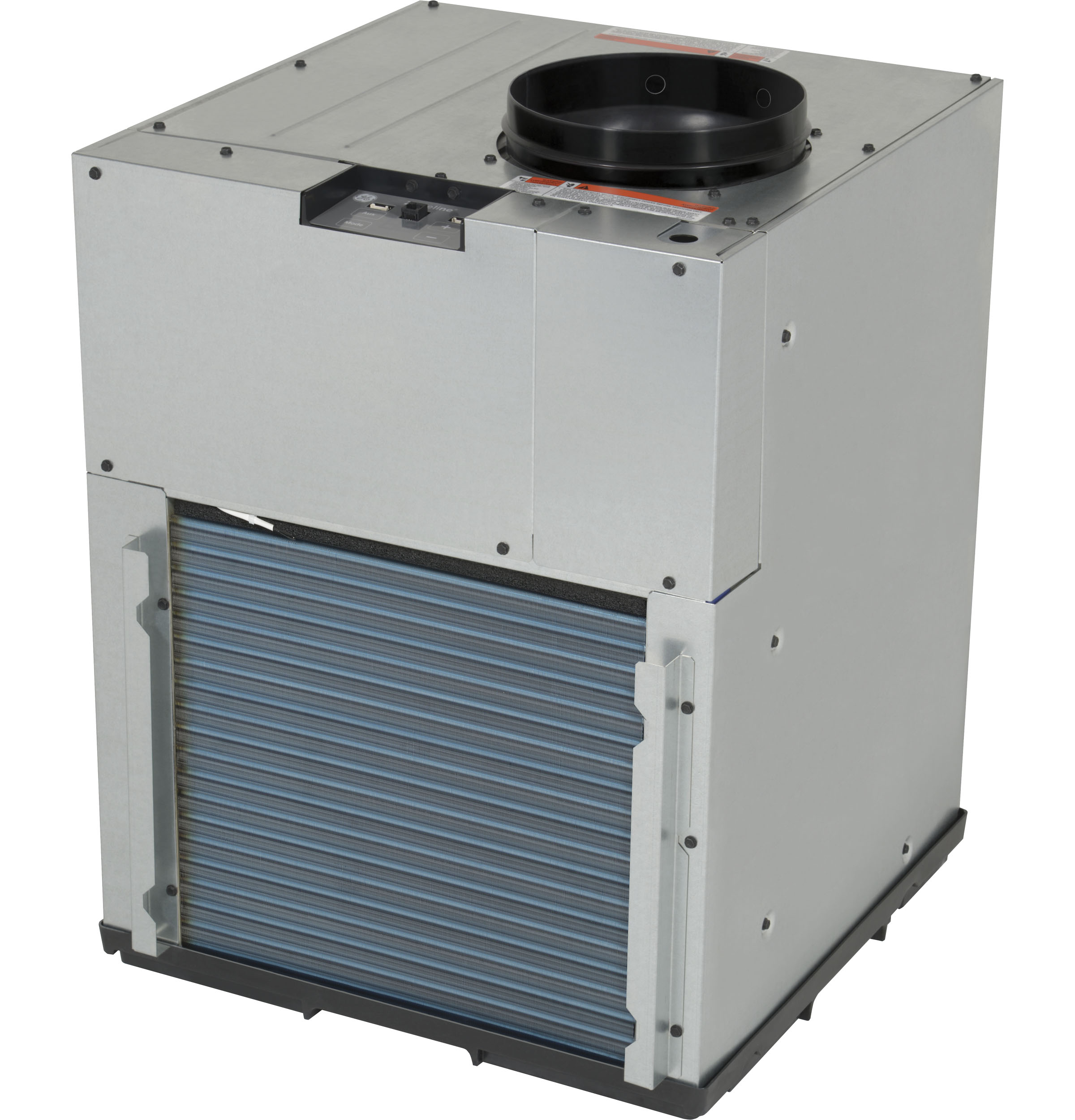
The VTAC is flexible and can accommodate any space, from assisted-living facilities to luxury hotels to offices.
One of the aspects that makes the latest VTAC system so easy to install is the fact that it is a one-part equipment system versus a two-part equipment system. It can be installed entirely from the inside of the building whereas other systems often need more than one person to help install from both the inside and outside. As seen in the previous section, the instant platform combined with 2 x 4s and an integrated draining system is flexible so that it can accommodate any space, from assisted-living facilities to luxury hotels to offices. The grille and telescoping plenum can adjust to the custom project. The 3-element universal heater provides 2.55 kW, 3.45 kW or 5.0 kW when connected with the appropriate 4-pin power connection kit and personality plug to 230-V or 265(277)-V power.
More than ever, it’s important for building owners to have access to technology that is easy to install and easy to replace — with or without skilled workers. New innovations in VTAC systems allow for easy installation that can be foolproof and up to 60% faster than other systems, which also saves time and money.
New VTAC systems can integrate with other technologies to elevate health, safety and well-being for the occupant. One of those accessories provides freshly circulated air called “makeup air.” The other targets pathogens and bacteria that may be harmful to occupants.
Makeup air
Makeup air is meant to replace, or “make up” for, the air that has been removed through exhaust fans. It works by pulling fresh air from the outside into the building to replace air that that has been removed. In the past two years, in light of the pandemic, this kind of solution has become more appealing for spaces that need greater measures of ventilation.
Good indoor air quality requires the building to both intake and exhaust air. When a space is ventilated but not replenished by another air source, it results in a negative pressure in the building. If the space is well-sealed, the negative pressure will make an exhaust system work harder and pull in unconditioned air through any means possible. A positively pressured building is best, and makeup air within VTAC systems can be a key component in effective building air management.
VTAC technology incorporates makeup air capabilities that help companies meet building code regulations. The technology has the ability to sense occupancy, running the makeup system only when necessary.
UV Systems
One accessory that will be a natural addition to VTAC in the future is the incorporation of ultraviolet light systems. Currently available for the packaged terminal air conditioner (PTAC), UV technology actively destroys microbial growth and viral loads from reproducing and spreading. Mold and fungus can, at best, affect the odor of an indoor space, but at worst, can lead to poor indoor air quality and have a negative impact on occupant health.
Using a high-powered LED array for maximum intensity and efficiency, this new technology applies UV-C light (the region of the UV spectrum most useful for disinfection) to air as it passes through the unit, focused and channeled where most air movement occurs to reduce airborne virus concentrations. The UV-C kit is customized to the latest VTAC technology and can be installed into existing products. The ultraviolet light in this air treatment system continuously cleans the coil and drain pan of the system, helping it run more efficiently and removing harmful pollutants.
UV systems have become more popular and seen more development over the past year and a half since the first U.S. shutdowns of the pandemic in early 2020. As people return to work or find new places to live, systems that can proactively fight pathogens have become not just a stop gap between pandemic times and “normal” times, but a solution for the long term. Building owners must come to accept the idea that prevention is key and that guests and residents now expect more technologies that will ensure healthy buildings.
Standards and testing
Testing, adjusting and balancing (TAB) is necessary for all air conditioning systems so that they perform optimally and provide occupants comfort, safety and health at low cost. Performance tests include energy efficiency testing, which makes sure energy usage is as low as possible without lowering comfort levels. Acoustical and airflow testing checks the airflow within the building to make sure it is working to its highest level, while maintaining a comfortable noise level. Finally, air cleaner testing examines how well the system cleans the air, aiming for the best possible indoor air quality (IAQ). The test is important for all occupants but especially those who have respiratory issues or developing bodies, such as children.
Accessibility compliance
VTAC products are tested for compliance with American with Disabilities Act (ADA) and the Uniform Federal Accessibility Standards (UFAS) in order to help make appliances and architectural elements accessible to people with disabilities. The five requirements for air conditioner accessibility includes standards for forward reach, forward approach, side reach, control operation and location of controls. Maximum high forward reach for controls and operating mechanisms is 48" and minimum low forward reach is 15 inches. Controls and operating mechanisms must be operable with one hand and should not require tight grasping, pinching, or twisting of the wrist. The force required to activate controls should not be no more than 5 pounds.
Testing standards
Air conditioning units such as a VTAC system is tested in accordance with ANSI/ASHRAE Standard 37 using the operating conditions specified by the manufacturer’s installation instructions.
For single package vertical air conditioning systems, the testing must show that the unit can provide air-circulation, air-cleaning, cooling with controlled temperature and dehumidification, and may include the function of heating, humidifying and ventilation.
In addition to what Standard 37 requires, the test data is only valid for tests conducted when the atmospheric pressure is greater than 13.700 psia. In addition, there are requirements for how condenser air temperature for air cooled products must be measured, how indoor airflow and ESP is set, how air enthalpy is specified, and what the secondary method for capacity measurement for all full-load cooling and heating tests is. Conduct secondary measurements in accordance with the provisions in sections 7.3, 7.4, and 7.6 of ANSI/ASHRAE Standard 37 that are applicable to the selected test method.
When using the outdoor air enthalpy method as the secondary method for capacity measurement it’s important to first conduct a test without the outdoor air-side test apparatus connected to the unit (“free outdoor air” test). Then attach the outdoor air-side test apparatus and conduct a test with the apparatus connected to the unit (“ducted outdoor air” test). Use measurements from the free outdoor air test (i.e., indoor air enthalpy method capacity measurements and power input) as the applicable measurements for determination of efficiency metrics, in accordance with the standard.
The free outdoor air test involves connecting the indoor air-side test apparatus to the indoor coil; but not connecting the outdoor air-side test apparatus. The test room reconditioning apparatus and the unit being tested must operate for at least one hour. After attaining equilibrium conditions, the following quantities are measured at equal intervals that span 5 minutes or less: The evaporator and condenser temperatures or pressures, and the parameters required according to the indoor air enthalpy method. These measurements are continued until the applicable test tolerances are satisfied for a 30-minute period (e.g., seven consecutive 5-minute samples).
To measure evaporator and condenser pressures, a thermocouple is soldered onto a return bend located at or near the midpoints of each coil or at points not affected by vapor superheat or liquid subcooling. Alternatively, if the test unit is not sensitive to the refrigerant charge, pressure gauges are installed to the access valves or to ports created from tapping into the suction and discharge lines. The alternative approach is used when testing a unit charged with a zeotropic refrigerant having a temperature glide in excess of 1°F at the specified test conditions.
For the free outdoor air test to constitute a valid test for determination of efficiency metrics, the following conditions must be met: For the ducted outdoor test, the capacities determined using the outdoor air enthalpy method and the indoor air enthalpy method agrees within 6%. Second, the capacity determined using the indoor air enthalpy method from the ducted outdoor air test and the capacity determined using the indoor air enthalpy method from the free outdoor air test needs to agree within 2%.
After collecting 30 minutes of steady-state data during the free outdoor air test, the outdoor air-side test apparatus is connected to the unit for the ducted outdoor air test. The exhaust fan of the outdoor air-side test apparatus is adjusted until averages for the evaporator and condenser temperatures, or the saturated temperatures corresponding to the measured pressures, agree within ± 0.5°F of the averages achieved during the free outdoor air test. Thirty minutes of steady-state data is collected for which the applicable test tolerances are satisfied. During the ducted outdoor air test, at intervals of 5 minutes or less, the required parameters are measured according to the indoor air enthalpy method and the outdoor air enthalpy method for the prescribed 30 minutes.
For cooling mode ducted outdoor air tests, the capacity is calculated based on outdoor air enthalpy measurements as specified in ANSI/ASHRAE Standard 37. For heating mode ducted tests, the heat capacity is calculated based on outdoor air enthalpy measurements. The outdoor-side capacity is adjusted to account for line losses when testing split systems. The outdoor airflow rate is used as measured during the ducted outdoor air test to calculate capacity for checking the agreement with the capacity calculated using the indoor air enthalpy method during the ducted outdoor test.
Why is this important? The reasons are mostly obvious, but important to note that beyond the goal of keeping occupants safe and comfortable, resolving any issues beforehand means reducing the probability of issues getting worse, leading to more costly repair and downtime.
Conclusion
In this course, you have learned how air conditioning technologies have evolved in meaningful ways as building owners and occupants take into account old and new problems, including those related to the pandemic. Vertical terminal air conditioning is one such technology that has shown savings in time and costs, addressing skilled labor shortages with self-contained and self-aligning systems that are easy to install. They also provide aesthetic appeal that air conditioning systems of the past have been unable to do, which offers a better experience for occupants and for designers who aim for better architectural visions. Finally, wireless programming and diagnostics technology give building owners more control over their systems and an ability to meet the needs of their occupants in ways that not only keeps them satisfied but offers better support for their long- and short-term quality of life.
Erika Fredrickson is an independent writer and editor focusing on technology, the environment, and history. She is a frequent contributor for continuing education courses.
